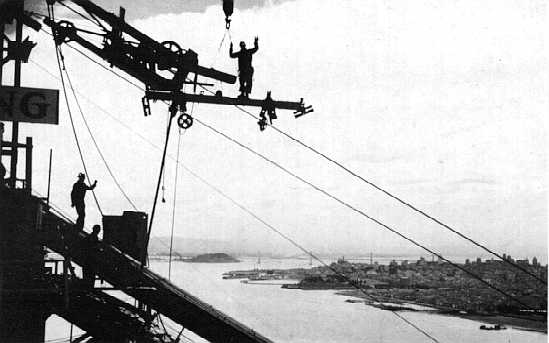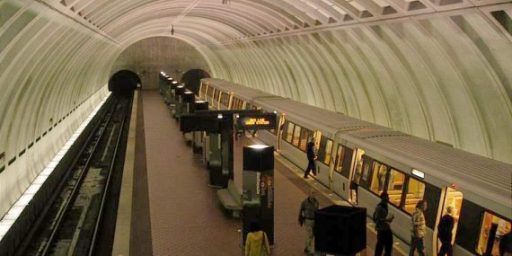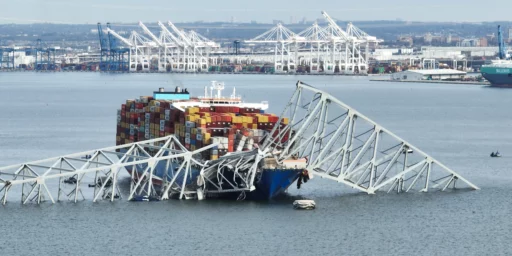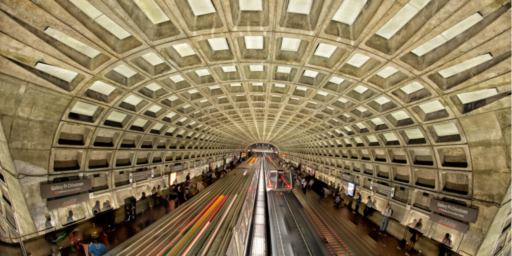Why Do Construction Projects Take So Damned Long?
Jonah Goldberg observes, "It took 410 days to build the Empire State Building; four years to erect the Golden Gate Bridge. The Pentagon took two years; the Alaska Highway just nine months. These days it takes longer to build an overpass."
Jonah Goldberg observes, “It took 410 days to build the Empire State Building; four years to erect the Golden Gate Bridge. The Pentagon took two years; the Alaska Highway just nine months. These days it takes longer to build an overpass.”
Naturally, he blames government red tape. But while I’m sure that’s a part of it — maybe even a significant part of it — that can’t be the main reason. Sure, we have all manner of regulations mandating higher degrees of inspection, worker safety, and the like — which I generally support — and there are the environmental impact statements and whatnot — of which I’m more skeptical — but that can’t possibly account for more than, say, a doubling of the time it takes to get things done.
Additionally, I’m rather confident that the engineering, equipment, training, and other things going into these projects is leaps and bounds above what it was when those fabled projects of yore were built.
The DC Metro area is constantly under construction and, because our infrastructure is so overburdened as it is, it’s a nightmare to shut down bridges, interstate exits, and even single lanes of significant roads. The Woodrow Wilson Bridge project has been going on for more than a decade with no end in sight. They’re shutting down one of the exits to Tyson’s Corner from the Beltway for two years to do something or another. I’m sure it’s necessary but don’t know why.
Anyone out there care to enlighten me?
via Glenn Reynolds







I’ve wondered about that a lot myself and I’m glad to find out it’s not just me. My hometown had a two-lane bridge over I-95 that became a four-lane bridge over the course of what seemed like three years. At that rate, how long would it have taken to build the entire interstate itself?
My guess is it has mostly to do with the tremendous burden of working around other people. For instance, on the Beltway you can really only do most of the lane-closing work at night, and the first and last hour or so is wasted putting down cones and picking them up again, etc. On the other hand if you get a sealed-off construction site work can still get done quickly. Modern professional sports stadiums, which are probably at least as complicated as the Empire State Building was, still take only 12-18 months.
That Jonah blames the government is not surprising but it’s ridiculous. Gov’t red tape probably leads to lots of time tied up in the planning steps but not a lot of time once the actual asphalt is laid.
The Empire State Building was a notorious Depression era project and there was a ridiculous number of laborers, which is one of the reasons it was built in a ridiculous amount of time.
The Golden Gate Bridge was likewise a Depression era project and probably had the same circumstances.
The Alaska Highway and Pentagon were built around the same time and, due to the war, were given high, high priority.
These are the exceptions rather than the rule I would say. That explains part of it.
99% of construction delays from the government happen before the project actually begins. Once ground has been broken, most of the delays come from the fact that construction has an enormous number of variables. Anything done outdoor is exceptionally weather dependent (can’t lay asphalt when it’s cold, can’t lay concrete when it’s wet). Any renovation to an existing facility often has all kinds of issues that pop up and delay the project.
When you have sub contractors, you often have them scheduled assuming your calendar will work. These subs are also scheduled with other general contractors for other jobs, so they might not always be available if the project is delayed, which delays the project further and so on and so on.
If Goldberg is really interested in the impact of government red tape (and he isn’t), the issue to look at is how long it takes a project from the day an architect starts his drawings to the day that ground is actually broken.
Allow me to speak to an area of my expertise: Another major issue is that these days there’s just a lot more STUFF in the ground. When you need to expand a road, I guarantee you that there are at least 8-10 utilities in the ground, including telecommunications, cable, oil, gas, water, power, etc. You have to coordinate relocations with all the utilities if you’re going to impact those facilities. That takes time and money. Moreover, they usually can’t all relocate at the same time. You don’t want gas digging in the ground the same time the water folks are. Power has to be done separately. Sometimes you can bundle the telecoms together.
So all of those utilities enter into agreements with the relevant government agency.
And this also doesn’t take into account property acquisition. If the government doesn’t own the land , they have to acquire it, and that’s a lengthy process even with Eminent Domain.
80 years ago, you didn’t have all of these issues. Right of way acquisition was easier and there weren’t as many conflicts with other companies, agencies and jurisdictions.
And all of this is on top of the issues that MM raises.
Really, the government regulations don’t slow things down much at all. It’s coordination with all the private entities that takes awhile.
Oh and the lane closure/scheduling issues that Andyman mentions are ALSO a major issue.
I suspect it has more to do with profit than with government. Companies overbook then shift their limited crews around to whatever is the more lucrative project. By keeping the number of employees down they maximize profit. Just a guess.
This is mind boggling when you think about it.
Two situations. The World Trade Center. They had architects to submit their drawings and that must have taken a year or two. I am sure there was arguments on what style. Trump had a simple answer. “Build the same towers making them one story taller.
The U.S. and Canada wants to build a new bridge between Windsor and Detroit, and there was a lawsuit from the owner of the Ambassador bridge. So that has delayed things. This lawsuit could take years.
http://www.thenewsherald.com/articles/2010/03/29/news/doc4bae290261399738864651.txt
This second article tells about the whole mess with legislatures, Canada, Michigan, and the Ambassador Bridge owner.
Oops, here is the article.
http://www.cbc.ca/world/story/2010/05/27/wdr-dric-bridge-house-100527.html
My brother-in-law supervises road construction/improvement for the state; I think I detailed his particulars on this topic at Schuler’s place, but I would say there is a labor shortage. His division has not completed half of the work they were supposed to get done this year. Overtime = PDS gets college football tix.
The first problem is that there are only so many people in this business and they tend to rely upon the same pool of subcontractors when they need more labor. They also have a finite pool of heavy machinery and equipment to use. The companies that bid on work were all bidding on projects from cities, counties, special districts, state and federal government at the same (all presumably deriving from the same funding source). It’s possible for a bidder in good faith to wind up with more work than they can perform or sub out. The government can put the screws on the successful bidder who can’t keep the time commitment, but if they try to replace them, they’ll need to rebid and risk losing the stimulus support if it can’t be completed in time.
The second problem is government staffing. The feds rejected numerous projects from my state, calculating it was _impossible_ for that work to be done given state oversight capabilities. That left projects that were merely difficult to perform.
The third problem is reliance on outside consultants to fill in the gaps for government oversight. They are getting flush, and are not showing up for work.
The conceptual problem is assuming that in today’s age that a guy losing his job from a bank merger is capable of doing road construction. Condescension.
I suspect it has more to do with profit than with government…
Yes, of course. Because in the good old days they weren’t concerned with profits. Just ask Upton Sinclair or Charles Dickens. Not to mention the curious correlation between the size of government and the length of time it takes to get things done. Probably just a coincidence though. Just curious, but have you ever considered broadening your horizons and getting outside the echo chamber, if only for a few minutes?
But seriously, the reasons for longer construction times are manifold. Government regulations from environmental concerns, the ADA, fire and safety codes, etc., certainly contribute, but so does the increasingly litigious nature of our society, NIMBYmania, the more complex infrastructure that Alex spoke to, and the fact that any building going up now is a lot more complex, in and of itself, than it used to be to acocmodate all the extra cabling, “green”-ness, and the greater demands of tenants and consumers. Not all of this is bad, but it is real.
IIRC my history on the construction of the Hoover dam and the other western dams, these guys were working hard round the clock with poor food and shelter to get these things done in a way that boggles the mind. And then of course there were the death tolls.
I DO NOT want people to work that way today, but I’m not sure “doubling” the time does justice to a whole different set of realities.
charles reminds me of something. My state spent it’s allocation of stimulas largely on repaving existing roads. I know other states took more time to plan and design something with greater long term impact. Essentially, my state time-shifted road repairs. That’s why I tend to think the stimulas isn’t going to pay for itself, but other states might have used the money to improve the infrastructure in a way that will pay dividends in the future. That state is not Illinois.
PD –
Yes, you make another good point. Safety and health concerns also have an impact. The Brooklyn Bridge is a case in point….
Time shifted spending is stimulative, and it reduces government crowding out in the recovery.
It’s classic counter-cyclical spending.
Obama’s fault…
jp: You touch on a point of confusion and consternation for me. I can look at the Hoover dam and admire the economic multipliers derived from it (and look pass the environmental damage and the death toll), and realize that the government expenditure will largely pay for itself. Resurfacing roads a few years earlier than otherwise is not going to pay for itself; it might avoid layoffs, but my brother-in-law and his co-workers is working overtime, thus I get the football tix, and the unemployed do not become employed. It’s very, very, very. . . low efficient stimulus.
PD, stimulus is different than return on investment. In some cases you might get both, but not always.
Yes, it is about avoiding layoffs (“creating of saving jobs”). The idea behind stimulus is that a contraction has reduced utilization of productive capacity. Factories close, construction teams are laid off, people go home.
http://economistsview.typepad.com/economistsview/2010/10/industrial-production-and-capacity-utilization-fall.html
The follow-on effects are less spending in the consumer sphere, less new washing machines purchased, fewer trips to Disney World, etc.
Stimulus and that much contested multiplier are about getting the idle people working, and spending, again. The extreme proponents of stimulus believe that every dollar lost in the private sector contraction should be replaced … but those folks are rare. Krugman is just about out there.
There is also ROI, sure. Some new projects are supposed to have wider long term impacts on business activity. A big dam that makes cheap electricity will benefit the region for a hundred years (or until it silts up).
(I assume they didn’t grind off useful life from those roads, in order to resurface them … or that net-net the investment extends the next resurfacing well beyond what it had been.)
The technology has changed. It takes longer to build a Boeing 777 than the Wright brother’s plane too.
I suppose actual road crews are less labor intensive than they have been in the past … but heck Caterpillar has been having a good year.
This dovetails nicely with Michael’s explanation, above, and it also comports with my experience with government contracts. There are only so many qualified vendors. The qualified vendors don’t have incentives to expand to execute the jobs faster because, as PD points out, doing so takes time and money.
Back in the Depression, manual labor was something that just about anybody with an able body could do. It didn’t matter if he was a farm worker or an out-of-work stock broker. Now, most construction jobs require a certain level of training in the use of equipment and materials if the job is to be done well and be done safely.
I think training courses could be set up to make up the difference, but I don’t see anyone leaping at the opportunity to do so. Or to train for manual labor jobs.
Personally, I’d like to see a total freeze on new spending for any and all ‘social programs’ and money be allocated to repairing and replacing existing infrastructure, at least for 10 years. What we have is falling apart. I guess there aren’t many congressmen who would prefer to have their names put on temporary construction/repair signs than on new stadiums or convention centers.
That almost sounds like a stimulus project. And a successful one.
>Personally, I’d like to see a total freeze on new spending for any and all ‘social programs’
Hmm. So we should punish folks in wheelchairs and the mentally ill because our infrastructure has been neglected during the conservative era? Guess that makes sense in a right wing kind of way.
Who said punish? They can wait in line for things beyond those that serve all people in the country–including the handicapped. They have special needs; those will be accommodated as everyone’s needs are met.
I wonder which history books you’re reading to find that it’s conservatives who have not funded infrastructure? My books say that both parties governed over the past 50 years. Both parties have booted it.
http://www.asce.org/reportcard/2009/
> They have special needs; those will be accommodated as everyone’s needs are met.
Do you have anyone in your family who is handicapped or mentally ill? You really don’t sound very informed on the subject. If you wait until “everyone’s needs are met” to give these folks the help they need, you will be attending a lot of funerals.
> My books say that both parties governed over the past 50 years.
Allow me to be more specific. I consider 1980 – present to be “the conservative era” The GOP has spent a lot more time in the White House and has, to a great extent, controlled the national agenda and conversation.
Funny how a temporary “freeze” on “new” spending is considered punishment by some. This reminds me of the common bureaucratic tactic of calling a smaller-than-expected budget increase a “cut.”
Funny how a temporary “freeze” on “new” spending is considered punishment by some.
> at least for 10 years.
How exactly is “at least 10 years” temporary? More like Stalinist long-term central planning.
Reminds me of the Fox News tactic of playing semantic games to obfuscate the truth of a given situation.
If you are in a wheelchair, if you are helpless, if you are mentally ill and in danger of dying in the streets, fuvk yes, that is punishment. If you don’t know that you need to get out and experience life in a bit more depth.
“Personally, I’d like to see a total freeze on new spending for any and all ‘social programs’ and money be allocated to repairing and replacing existing infrastructure, at least for 10 years. ”
Might be more useful to have a spending freeze on the military Bringing back the troops to protect the homeland and keeping it at that level will free up quite a bit of spending, more than enough to keep home forces strong and up to date. Let the world look after itself for awhile, it’ll probably do just fine.
anjin-san is right, we shouldn’t freeze federal spending. Instead we should restore it to say, 1980 levels.